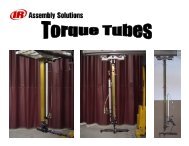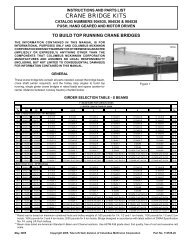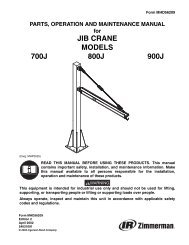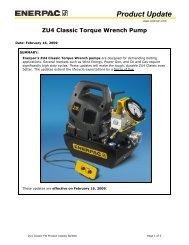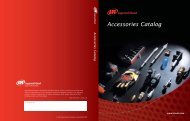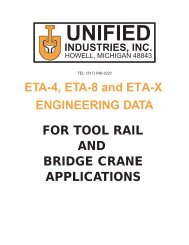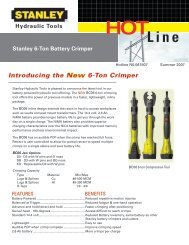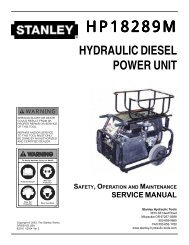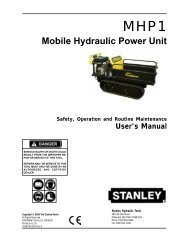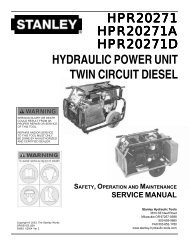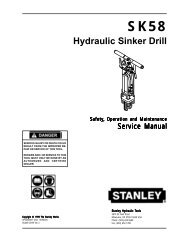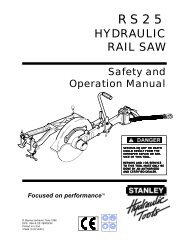Create successful ePaper yourself
Turn your PDF publications into a flip-book with our unique Google optimized e-Paper software.
Pre-operation Procedures<br />
Check Power Source<br />
1. Using a calibrated flow meter and pressure<br />
gauge, check that the hydraulic power source<br />
develops a flow of 7-12 gpm / 26-45 lpm at<br />
1000-2000 psi / 70-140 bar.<br />
2. Make certain that the power source is<br />
equipped with a relief valve set to crack at<br />
2100 psi / 145 bar maximum.<br />
3. Check that the pump inlet screen and outlet<br />
hose are clean. Remove any obstruction<br />
before operating the pump. Refer to PUMP<br />
CLEANING PROCEDURES.<br />
Connect Hoses<br />
1. Wipe all hose couplers with a clean, lint free<br />
cloth before making connections.<br />
2. Connect the hoses from the power supply to<br />
the tool fittings. It is a good practice to<br />
connect return hoses first and disconnect last<br />
to minimize or avoid trapped pressure within<br />
the tool.<br />
3. If hose couplers are used, observe the arrow<br />
on the coupler to ensure that the flow is in the<br />
proper direction. The female coupler on the<br />
tool port is the inlet pressure coupler. This<br />
coupler should be connected to the port<br />
closest to the water outlet.<br />
Pump Operation<br />
CAUTION<br />
Observe the following for Equipment protection and care.<br />
Note: The <strong>SM50</strong> pump is NOT DESIGNED<br />
FOR USE WITH A SUCTION PIPE INLET.<br />
The diameter of the suction screen at the<br />
bottom of the pump provides maximum<br />
pump efficiency. Reducing the size of this<br />
inlet will greatly reduce pump<br />
Operating Instructions<br />
9<br />
performance.<br />
1. Connect a hose fitted with a 3 in. / 76.2 mm<br />
female camlock coupler to the pump outlet<br />
fitting. Make sure the fitting is securely<br />
tightened.<br />
2. Lower the pump into the liquid to be pumped.<br />
Locate the outlet end of the discharge hose to<br />
disperse the liquid as required. Remove any<br />
kinks from the hose to assure maximum water<br />
flow.<br />
3. Energize the power source. Watch for solids in<br />
the liquid being pumped. If solids are<br />
excessive, the discharge flow may decrease. If<br />
this happens, stop the pump and check for the<br />
cause of the problem.<br />
Under some conditions, the liquid being pumped<br />
may be slowed enough so that it can no longer<br />
push particles in the liquid. If this happens,<br />
particles can accumulate in the hose and back<br />
up to the pumping chamber, causing further<br />
restriction. The impeller then acts as a "grinding<br />
wheel" which causes accelerated pump wear.<br />
Reduced liquid flow can be caused by the<br />
following:<br />
�<br />
�<br />
�<br />
WARNING<br />
Never Point the end of the hose at bystanders.<br />
The pump sinks into solids at the bottom of<br />
the hole.<br />
The end of the outlet hose is too high, causing<br />
excessive lift height for the column of liquid<br />
being pushed by the pump. This slows the<br />
flow of liquid to a level where it can no longer<br />
carry solids out the hose end.<br />
The flow and pressure of hydraulic oil to the<br />
pump is too low which reduces impeller<br />
speed. A 20 percent decrease in hydraulic oil<br />
flow can reduce pump performance by 50<br />
percent. When operating at reduced hydraulic<br />
flow and pressure, the end of the outlet hose<br />
should not be more than 30 feet above the



